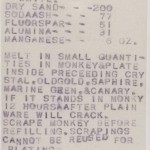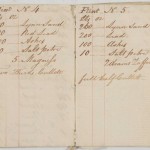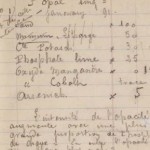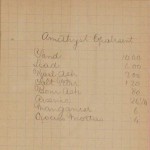When I first arrived at the Rakow Research Library 10 years ago, cataloger Kelly Bliss introduced me to one of her favorite collection items and it was one that stuck with me. It was small, not quite as a big as a credit card, handwritten in the most elegant slanted script, and full of arcane notes, numbers, and symbols. It was a batch book—the first I had seen. (Read Kelly’s blog post on this particular batch book.) Since then I’ve looked at many more, all equally interesting in their own ways. The Rakow Library last year digitized close to 100 batch books, and has made them available on our website for anyone to read, download or print. We have more to do, but these batch books comprise a large portion of the total.
If you haven’t encountered batch books before, you may not know that these are essentially recipe books for making glass. The batch refers to the pot of glass produced after combining all of the components—the sand, limestone, boron, lamb’s blood, copper, etc. Wait. Lamb’s blood? Yes, according to an 18th century manuscript in the library’s collection, lamb’s blood could be used to “soften crystal.” In the month of August, you could use goose and goat blood! Was animal blood really used in this particular way?
Perhaps or perhaps the glassmaker didn’t want to reveal the real secret to “softening crystal.” While not technically a batch book, these manuscripts record early efforts to preserve the knowledge of the glassmaker, a tradition that continues today. Think of the knowledge on glassmaking available on YouTube or hidden in posts on glassmaking discussion boards.
And while you find many artists today willing to share their glassmaking secrets, there are still those techniques, recipes, or tricks of the trade too hard-won to share wide and far. When one’s livelihood depends on protecting a recipe for a popular glass color, you can understand why glass companies often wished to keep their secrets. Take the recipes for Louis Comfort Tiffany’s famed iridescent glass which reside in small notebooks written in code! These notebooks were mostly penned by Tiffany’s chief chemist, Arthur J. Nash, who eventually passed them to his son, Leslie Nash, also a Tiffany employee. Leslie subsequently scrawled “keep it safe” and “don’t let anyone see you mix [the batch]” across pages in the notebooks.
Often the batch books in the Rakow’s collection are written by hand. Sometimes they are typewritten on almost transparent onionskin paper, carrying with them the unique lines and faded ink marks of the typewriter used to produce them.
- William Leighton Batch Book, 1850-1857, CMGL 44510
- Batch Book by William Glaze, about 1810-1845 CMGL 89062
- “Cristal Opal,” Unidentified batch book, 1891 CMGL 88845
- Recipe for Amethyst Opalescent from Locke Batch Book
They also carry the imprint of the author’s personality. In some, the words are scrawled across the page, defying the tidy graph paper below. Others are unbelievably neat, so much so that school kids visiting our library cannot believe they are handwritten. Some are businesslike, others convey an air of neutrality and scientific objectivity—the scientist recording observations and conclusions.

Drawing from “G. Book” by an unknown glassmaker,
Account Book, with recipes, about 1880-1885, CMGL 2080
Some combine recipes with notes on equipment, labor, drawings of furnaces and other useful bits of information. One manuscript from the 19th century also contains newspaper clippings and the author’s notes about fighting the common cold.
The secret nature of these little books is as intriguing as is the care with which they were composed. A scientist, glassmaker, or artist may find the chemical formulations of interest or the furnace drawings. For me, though, the batch books represent the curious hydra that is glass technology—a chemist draped in a magician’s cape, who carefully constructs a palette for an artist.
The Rakow Research Library is open to the public 9am to 5pm every day. We encourage everyone to explore our collections in person or online. If you have questions or need help with your research, please use our Ask a Glass Question service.








13 comments » Write a comment